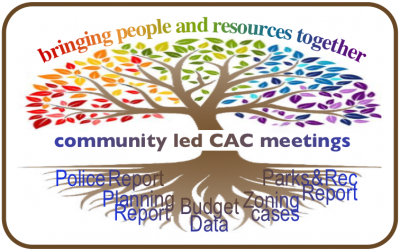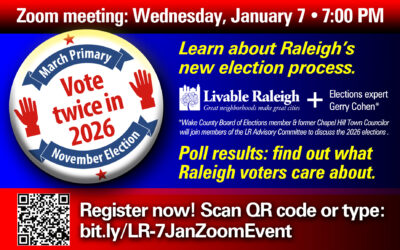New Citywide Poll of Raleigh Voters Reveals Council is failing on Affordable Housing, Transportation and Citizen Engagement
December 2, 2025 City Council Meeting
Highlights from December 2, 2025 City Council meeting.
It’s Up to City Council Now
The RCAC has done its part. It is now up to the Council to bring this across the finish line. Yes, the additional benefits outlined in the Tier approach carry a cost, but this is not because of the addition of the CACs. The additional cost burden is because the benefits are being applied across the entire Engagement Network so that other organizations can share those same benefits that the CACs have enjoyed in the past.
When and How does Raleigh Vote? – Event Rescheduled
The next election for Raleigh Mayor and City Council will be held November 3, 2026. But there’s a brand-new primary election first, on March 3, 2026. With a deadline for candidates to file and get on the ballot THIS YEAR — by December 19, 2025. Join Livable Raleigh Advisory Committee Members and our guest Elections Expert Gerry Cohen on Wednesday, January 7, at 7pm for a ZOOM meeting to learn all the details.
All residents’ voices MUST be heard.
The current proposal to eliminate boards — or to merge multiple community-focused efforts into a single entity — is deeply disappointing. As a volunteer commission, the HRC is not structured to provide adequate attention and voice to the wide range of community issues.
Mayor Cowell talked compromise for 6 months. What happened?
The approval of Z-12-25 was a huge disappointment to many of the residents in Raleigh’s neighborhoods. What is most disappointing is that there was a workable compromise that would have respected all parties.
Aggies DO! If you don’t, Get Out The Way!
Byron Laws spoke to the Raleigh City Council on the topic of the City Council approved African American Affairs Board that has never been seated. Byron is an Aggie and says Aggies DO! If you don’t, GET OUT THE WAY!
City Council Meetings October 14, 2025
Updates on the Comp Plan and the Mobility Study. Public comments on the noise ordinance as well as the Big Branch Greenway connector, changes to City Boards and Commissions, community engagement, Dix Park, and issues with GoRaleigh. A number of bus drivers are concerned about their own safety and other working conditions.
City Council Disappoints Again with Z-12-25
The City Council’s decision to approve the rezoning case on West Street (Z-12-25), adjacent to the Glenwood-Brooklyn neighborhood, is hard to understand – unless, that is, you understand that a majority of Council always approves rezoning cases, no matter how outsized, because the development industry controls them.
Been There, Done That!
The city has grown enormously in the past few years, as people from all over began to recognize it’s a great place to live. But this growth was accompanied by absolutely no planning – or bad planning – which means we are now living in a helter-skelter atmosphere akin to a Third World city in which anything goes. Along with this has come a lapdog attitude when it comes to the city council’s relationship with developers. Sound familiar? This commentary was written 5 years ago in 2019.









